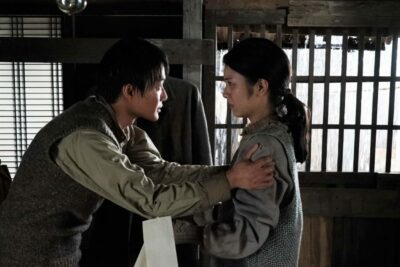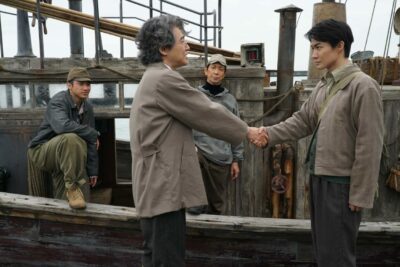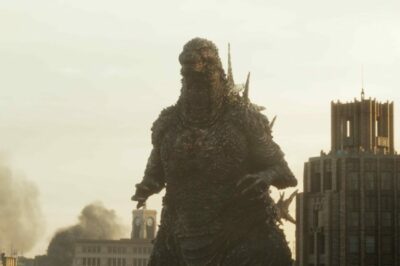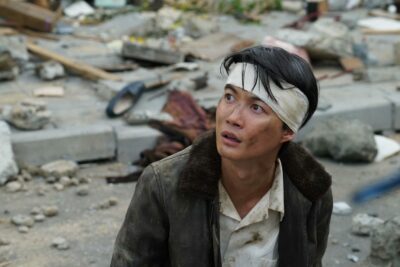In Godzilla Minus One, the titular mutant plods and barrels—lumbering, lo-fi, and virtually impervious to heavy artillery. Every few minutes, his scaly spine turns electric blue, radiation surging toward atomic levels, preparing to unleash a heat ray. Nearby, a Japanese woman, Noriko (Minami Hamabe, playing an adult orphan tasked with raising an orphan), sits on a train staring out the window, stupefied in horror by the nuclear wreckage. Her calm shock and awe are almost catatonic, as if locked in disbelief that carnage could be materializing again: that the mass horror of widespread destruction could be so pervasively and routinely inescapable.
Set in Tokyo (the Ginza district, specifically) circa 1947, Noriko is stunned by the appearance of yet another atomic catastrophe. After all, the ailing Japanese economy is still reeling from the post-World War II scars of a stinging defeat. Not yet two years removed from the economic, political, and spiritual wreckage, Godzilla hovers over Tokyo again like a taunting menace of resurgent doom and vengeance. A bulky byproduct of nuclear fallout, the reptilian mutant forces the beleaguered nation to confront yet another foreign and potentially apocalyptic threat—a threat that may or may not also be the nightmarish sublimation of its guilt-addled psyche.
Meanwhile, Shikishima (played by Kamiki Ryunosuke), a kamikaze fighter beset with trauma and remorse, rushes toward Noriko and the mayhem in Ginza, eager to vindicate previous shortcomings. After prematurely quailing from a kamikaze mission (which he cowardly blames on a flimsy airplane) and freezing up during a direct encounter with Godzilla on Odo Island, he is a shell of a man—mired in humiliation and ruefulness. He spends the bulk of his time stewing over his craven indecisiveness, trying to grapple with the reality that he could not muster up enough bravery to act when his fellow compatriots and countrymen needed him the most.
Fortuitously, a random meet-cute with the aforementioned Noriko reinvigorates his post-war resignation to a degree. A vagrant running from police over an apparent act of petty thievery in a public market, Noriko impulsively drops an orphan she’d just haphazardly adopted into Shikishima’s hands. After waiting around in hopes of Noriko’s return, Shikishima leaves the market only to find her hiding in a small alley, waiting for his departure. Before long, the three broken, orphaned, outcast souls form a makeshift family, but their situation is still far from ideal. Unable to produce milk or breastfeed the baby, they must find a way to survive the dire post-war conditions.

Soon, Shikishima finds an opportunity to make money, accepting the precarious position of an oceanic minesweeper. The job also allows him to exorcize his paralyzing self-reproach and shame with a productive gesture of contrition, giving him a task where he can valiantly risk his own well-being to nourish a child and support a ragtag family. The very danger of the profession is consequently desirable, allowing Shikishima to rectify wartime failures by safeguarding the innocence of a child and economically underwriting their future. However, even with this act of atonement, he’s still beside himself with nightmares. He doesn’t know whether he’s living or dead and somnambular in a dreamlike purgatory. Spiritually tattered, he still seeks absolution. To achieve it, he will need to tap into the depths of parental love and find the courage to sacrifice his own life for a child, for a family, and for the preservation of the nation.
This simplistic backdrop creates the perfect emotional, mythological, and topographical balance. It also mirrors the film’s fusion of old-fashioned melodrama intermixed with monster movie parable, recognizably set as it is within the well-known canon of one of the 20th century’s most notorious, celluloid behemoths. Earnestly straightforward and emotionally compelling, Godzilla Minus One thus feels like a recidivistic novelty in the modern blockbuster multiverse. And yet, to call such qualities novel or refreshing is deeply ironic, given how traditionalist and antiquated the film treats its characters and period piece trimmings.

Nevertheless, Minus One offers the rarefied sort of outmoded storytelling we get so little of these days, wherein political and socio-cultural commentaries play second fiddle to timeless themes about characters battling inner demons. Contrary to the recent IP outpouring of its Western big-budget counterpoints, which begrudgingly treat character development as window ornaments set in place to satisfy leaden genre expectations and ossified narrative prerequisites, Godzilla Minus One privileges character arcs above all else. The recurring standoffs with Godzilla are still thrilling and look stunningly retro, but they feel ancillary to the human drama. It feels as if Godzilla was merely a monster set in motion to magnify existential underpinnings.
Adhering to its refreshingly humanistic template, it is a classical kind of film where a single theme—sacrifice—infuses the material with meaningful cohesiveness and continuity from the prologue to the epilogue. Whereas onscreen moral predicaments increasingly feel like perfunctory and secondary background fodder in blockbusters (perplexingly overshadowed by CGI-bludgeoned set pieces and mindless spectacles), Godzilla Minus One flips the script and inverts the spotlight. As Godzilla thrashes, scorches, and flattens Tokyo with symbolic power, the iconic monster mostly functions to intensify and elevate ethical dilemmas, becoming more of a psychic manifestation than a plot-propelling villain.

Notwithstanding this refreshing shift in narrative loci, Minus One has a few glaring, peripheral issues. If it were an American film, the discourse would already be inundated with pushback against the jingoistic propaganda riddling the plot. There is an arrantly nationalist emphasis on submitting oneself to the supremacy of the military-industrial complex, an ethos which is dangerously broadcast under the guise of selfless civic duty. This bellicose, pro-war attitude is particularly problematic given Japan’s role in WWII. Regardless of Godzilla’s mythological origins and the fictional alibis this gives the movie’s plot proceedings, the blotchy optics surrounding Japan’s role in the Second World War are not pretty. Far from a victim, the Japanese empire was a brutal, fascist, colonialist regime.
Thus, creating a World War II period piece about the power of sacrifice is tricky. Wisely, the film constantly highlights its protagonists’ concerns over geopolitical or historical commentaries. Any mention of the Soviets or the US is espoused strictly to fill plot points and mechanics. Instead of political subtext, the film grounds itself by focusing on a sympathetic ensemble of relatable characters who want nothing more than to defend their country and families from harm.
Everyone may function within the military complex, but their motives remain humane, localized, intimate, and interpersonal. This is especially true of the lead, Shikishima. Far from being a warmongering patriot, Shikishima exhibits solicitude for an orphan, dutiful guilt toward both his fallen and surviving comrades, and a deep reverence for the possibility that heroic martyrdom can protect the innocent and preserve the future. He is pensive and thoughtful, nurturing and aspirational, tortured and spiritually fractured, timid yet eager for rectitude, naïve yet wise beyond his years.
Quietly repentant and wistful, Shikishima feels cut out of a Ghibli movie. To say he feels akin to an anime character is a testament not to how broadly he’s written but to how universally relatable his personal and emotional journey becomes by the end. Debilitating regret and mournful agnosticism turn his character into an avatar for eternal themes, yet he never feels thinly realized, overtly figurative, or impersonal. There’s a genuine and sympathetic heartbeat behind his redemptive arc, a rare occurrence in the current landscape of spectacle-centered cinema.

Thus, while fixating on historical or political contexts is intellectually and historically fair, it would also uncharitably misconstrue the operatic scope and emotional heft of the human drama playing onscreen. Moreover, on strictly visual and structural levels, Minus One is a masterful piece of low-budget blockbuster filmmaking. It is suspenseful, evenly paced, gorgeously costumed, impeccably designed (at proper scale), beautifully shot with neutral sepia-toned filters, well-scored, and painstakingly choreographed—frame by frame. It is teeming with clever visual conceits and dramatic motifs that are shrewdly established early on and majestically punctuated with emphatic resolutions during the denouement.
Old-fashioned or not, the final set piece brings all the details and elements together with exquisite synthesis. We see the power of teamwork and celebrate the last-second arrival of civilians in tugboats. We admire the ingenious schemes of science and technology deployed to capture and annihilate Godzilla. And we learn that sacrifice is a noble, dignified gesture that need not always end in martyrdom. The final showdown with Godzilla—involving a deep oceanic trench, freon bubbles to sink the mammoth reptile, death by subaqueous decompression tactics, a kamikaze plane, and underwater flotation devices—easily offers the most effective/entertaining blockbuster finales since Top Gun: Maverick.
While similar in many respects, both films share one highly conspicuous commonality: They each set up the last mission in vivid detail, mapping it out plainly to orient audiences during the climactic act before adding an unexpected thematic and narrative wrinkle. Here, the twist is given with a smirk and a wink—boastingly revealed via flashbacks like a con man laying out the secret machinations at the end of a heist flick. We then get another twist, which, if in a more layered or nuanced movie, might feel manipulative, saccharine, and cheap. Here, it tugs on all the familiar heartstrings with a nostalgic sincerity that brings everything—the film and its atavistic charm in the current theatrical milieu—full circle.



Nice! I was just intuiting tonal and thematic similarities so that’s fascinating to learn!
Keen that you picked up on the Ghibli feel given the director has mentioned that Miyazaki was an influence on the making of this film
I second that! While watching the movie and afterwards I thought much about how the film’s heartfelt human portrayals felt like Miyazaki. So glad that master storyteller’s influence is influencing other works like this, elevating them above their genre B-movie roots.
Thanks for reading! Great movie 🙂
Your review is a masterpiece!